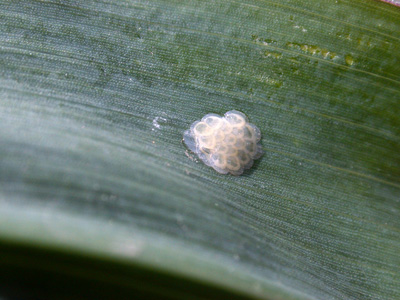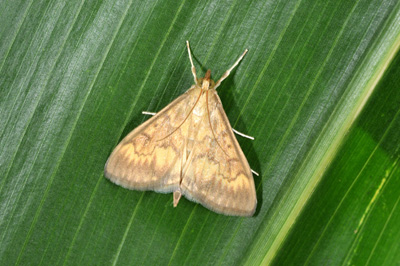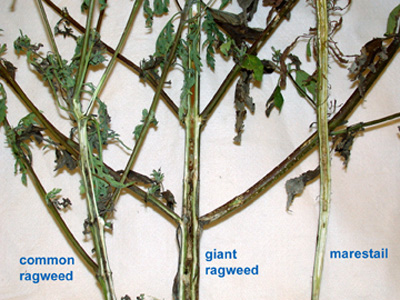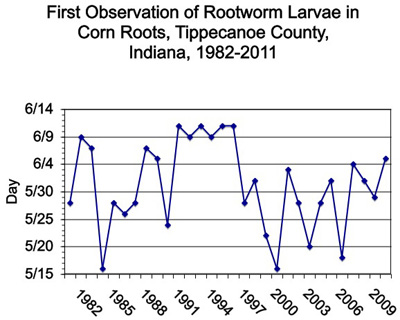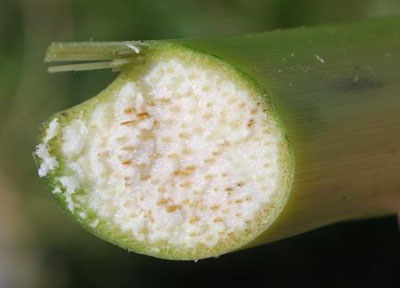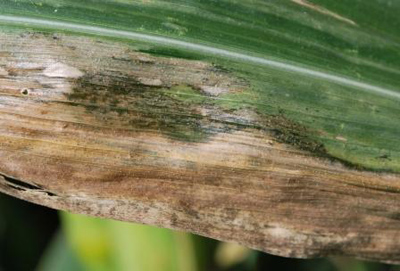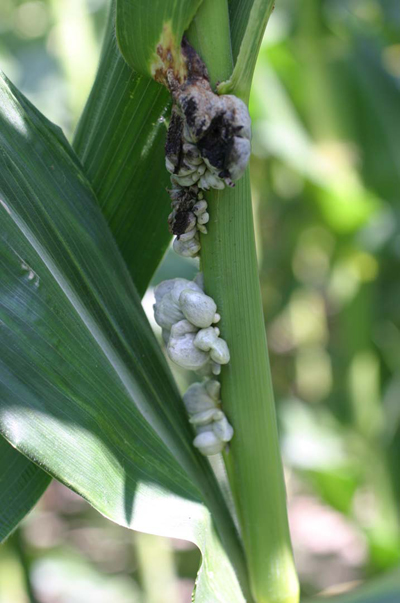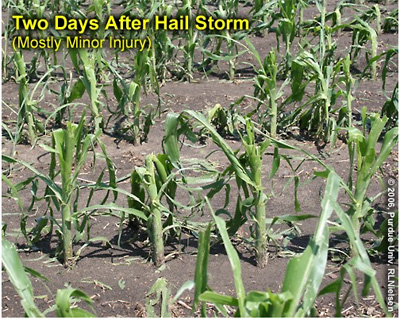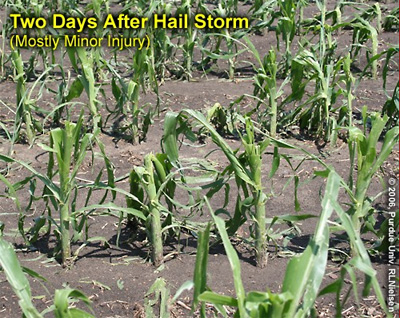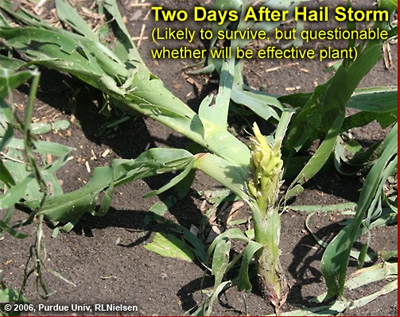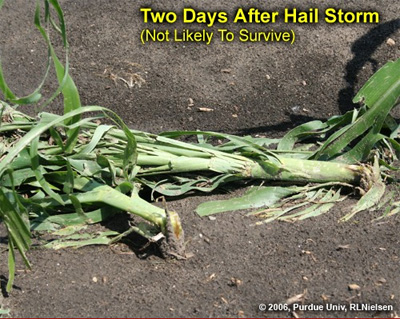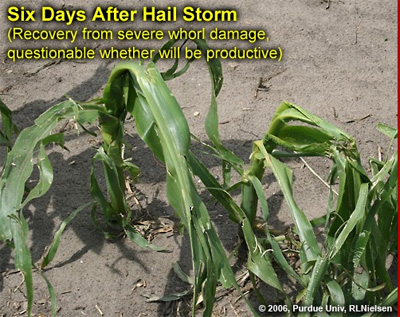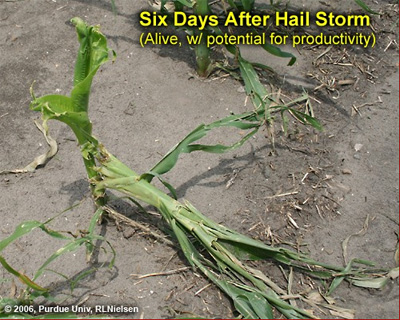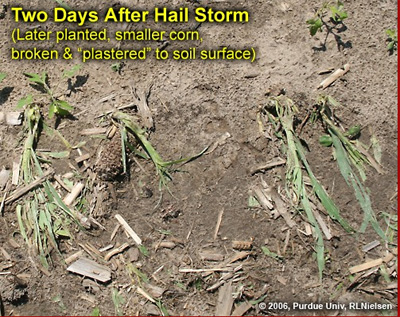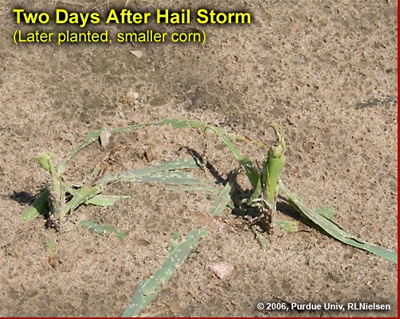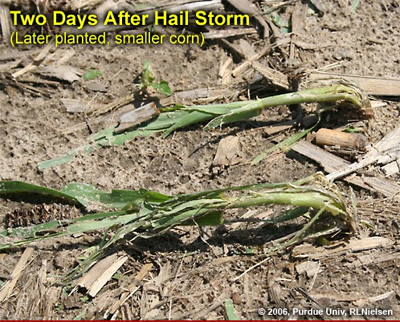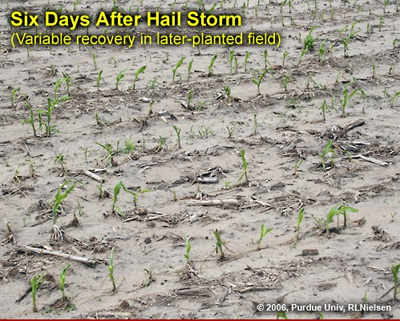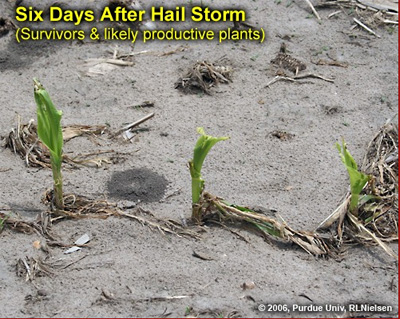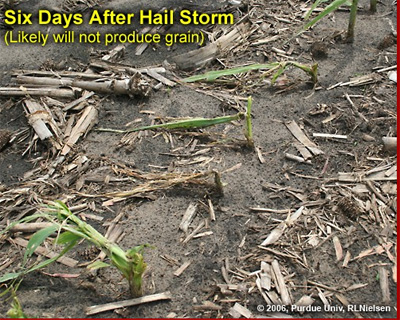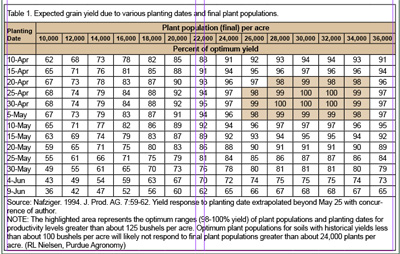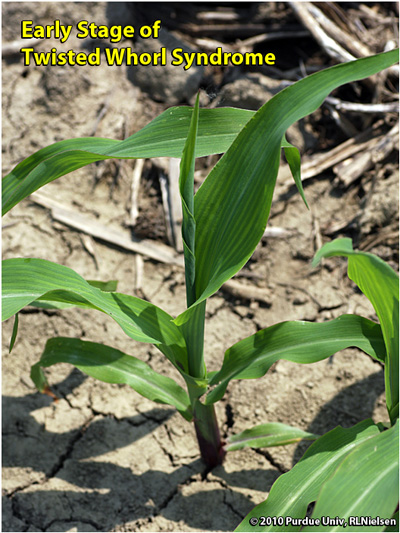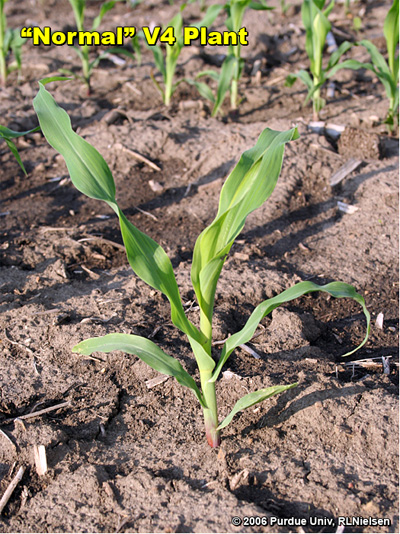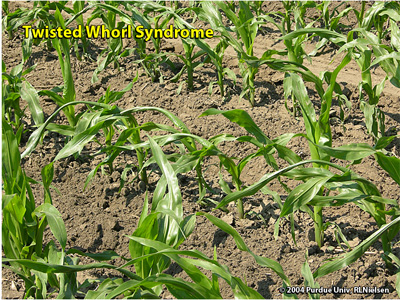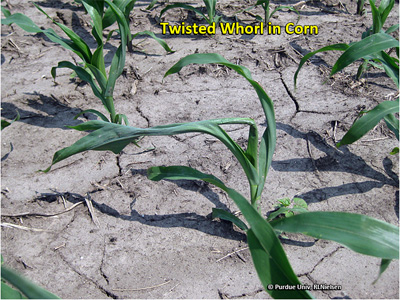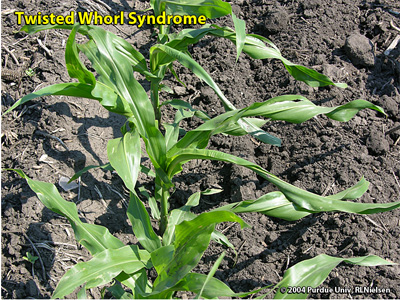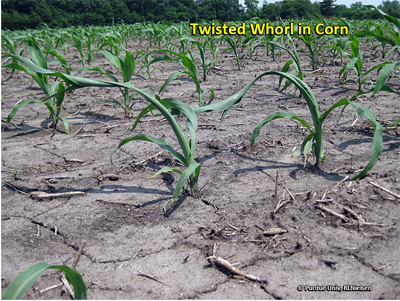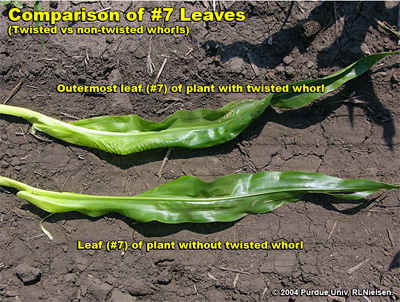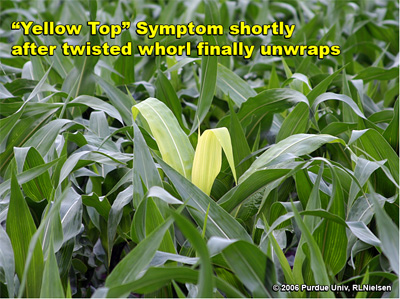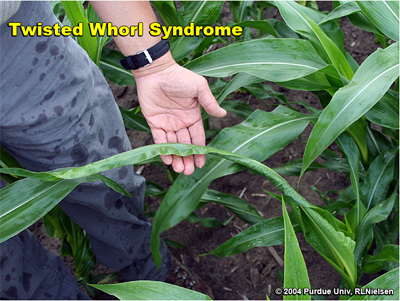European Corn Borer, Forgotten But Not Gone – (John Obermeyer and Christian Krupke)
• Moths are now flying, mating and egg-laying.
• Many non-Bt crops and plant species serve as a food source for this pest, don’t be unpleasantly surprised!
• Weed control may be reduced because of corn borer’s tunneling.
Black light trap captures of European corn borer moths within the last week reveal that this once dreaded pest has not become extinct. True enough, the widespread use of Bt-corn for over a decade has greatly diminished this insect’s numbers. Fact is, that they haven’t gone away, partly due to their multitude of plant hosts ranging from crops, weeds, and ornamentals. Over the last several years, we’ve received occasional calls from individuals that neglected scouting for this pest in unprotected corn that were unpleasantly surprised at its presence and damage. This caution is to growers of all vulnerable crops, e.g., non-Bt field corn, popcorn, peppers, potatoes, hollyhocks, etc.
The first-generation European corn borer moths are flying now (see Black Light Trap Catch Report). They are attracted to many different plants for egg-laying, usually those taller and healthier than neighboring plants. One indicator of the moth’s presence and numbers in a local area is noticing their evening mating activity while driving along roadsides or other grassy areas. This “wind-shield” splatter technique should be an alert to begin looking in crop fields for their egg masses laid on foliage and/or hatching larvae. For field crop producers, early planted non-Bt corn that is noticeably taller than neighboring fields should be inspected soon. Larvae feeding in the whorl, creating a “shot-hole” appearance, are very treatable with foliar insecticides. Once larvae begin boring into midribs or stalks, efficacy is greatly diminished.
Corn borer egg mass, likened to fish scales
Female European corn borer on corn leaff
Insect tunneling in weeds results in poor herbicide translocation
Another negative concerning this insect is their affinity for infesting weeds, especially giant ragweed. Now initially this sounds like a good thing. Problem is, corn borer don’t kill the ragweed, their tunneling prevents translocation of herbicides such as glyphosate throughout the plant. So treated weeds may look miserable for a time, but in time begin to send out regrowth from growing points that didn’t receive herbicide. Any tall, giant ragweed out in fields right now still yet to be treated?!?!
![]()
Corn Rootworm Hatch Has “Officially” Begun in West Central Indiana - (Christian Krupke, John Obermeyer, and Larry Bledsoe)
• Hatch of rootworm in WC Indiana occurred on or around June 6.
• Rootworm populations may take another “environmental” hit should heavy rains continue.
After searching hundreds of seedling roots from last year’s rootworm trap crop area, the first larva was found on Thursday June 9. Judging by its size, it emerged earlier in the week, likely Monday the 6th. This date is just the beginning of hatch, and really has little significance to producers. Rootworm egg hatch period is very prolonged, partially because eggs are laid at a variety of depths/temperatures. This year, the peak (highest activity) hatch will likely occur in later June. This underscores the fact that anyone still planting or replanting corn during the next two weeks should consider rootworm protection if they would typically do so.
The biggest question is what potential risk for rootworm damage exists this year. As explained many times, rootworm eggs are very durable and generally over-winter quite well…no matter how cold or even wet. Newly-hatched larvae are the vulnerable stage in the biology of this pest. They are especially susceptible to drowning in wet soils. The last few springs were notoriously wet during the late weeks of May and early weeks of June, when most larvae were hatching. Considering this spring’s rainy pattern, rootworm may be set for another rough season. Obviously this story will be played out during the next several weeks. Please keep us informed of your observations.
![]()
Click here to see the Black Light Trap Catch Report
![]()
Disease Risk for Storm-Damaged Corn - (Kiersten Wise)
Heavy rain, hail, and dust storms have blasted young corn plants in recent weeks. These storms can wound and shred leaf tissue, and can create entry points for disease-causing organisms. Even if leaves appear healthy, wind-driven rain and sand-blasting of plants can cause microscopic tears in leaves that organisms can enter if conditions are favorable for disease development. Before producers take steps to manage potential disease problems on storm-damaged corn, it is important to consider that the majority of our economically damaging diseases of corn, like gray leaf spot, do not need wounds to enter a plant. Therefore, fungicide applications for disease prevention may be unwarranted in storm-damaged corn. There are some diseases that may appear in storm-damaged fields, and here we will discuss what, if any, in-season management options are available for these diseases.
Figure 1. Discolored vascular tissue resulting from the disease Goss's wilt of corn
Figure 2. Lesions of Goss's wilt will have a dark black frecling within the lesion
Figure 3. Common smut on corn (Picture courtesy G. Shaner)
Sand-blasted corn is prevalent in northwest Indiana, an area with a history of the bacterial disease Goss’s wilt. The bacterium that causes Goss’s wilt survives through the winter on residue or perennial weeds, and enters corn plants through wounds. The disease can spread on wind-driven rain. There are two phases that can occur with this disease, a leaf blight, and a systemic wilt. Plants with systemic wilt can be diagnosed by examining the vascular tissue of the stalk. Infected vascular tissue appears orange to brown (Figure 1) and can result in plant wilting and stalk degradation. The leaf blight phase is characterized by distinct light tan to gray lesions filled with dark specks (Figure 2). Lesions will often appear shiny due to bacteria oozing onto the leaf surface. Blighted areas are common in susceptible varieties, and can be confused with sunscald or drought stress. The dark flecking and shiny areas within lesions distinguish Goss’s Wilt from another bacterial disease, Stewart’s Wilt, which has characteristic elongated lesions that run parallel to the veins.
There are no economically viable in-season management options for Goss’s wilt. Preventative measures must be implemented in areas where the disease has been severe in the past. Select hybrids (mainly popcorn or sweet corn) with resistance to the disease, and if possible, reduce the amount of debris remaining on the field through conventional or limited tillage practices. Rotation to soybean, wheat, alfalfa or another non-host can also help encourage decomposition of infected corn debris. Replanting corn into infected corn stubble is strongly discouraged in areas where the infection has occurred.
For more information on Goss’s wilt please see the Purdue Extension bulletin BP-81 <http://extension.purdue.edu/extmedia/bp/BP-81-W.pdf>.
Another disease that is common in storm-damaged fields is corn smut. This disease is rarely economically damaging, but can cause concern if galls form on young plants or if the fungus infects the growing point of the plant. The fungus that causes smut survives in crop residue or soil. Spores of the fungus can be wind-dispersed to fields where they can cause infection under a variety of conditions, but primarily enter plants through wounds. Again, there are no practical in-season management strategies for smut. Resistant varieties are the best option, especially in sweet corn and popcorn.
![]()
Recovery From Hail Damage to Young Corn– (Bob Nielsen)
- Yield loss from hail damage is based on reductions in plant population and leaf area.
- Allow a damaged field enough time to demonstrate the degree to which it may recover from hail damage.
As is usual in Indiana, early summer thunderstorms rumbling across the state often include damaging hail. Looking out the kitchen window the morning after such a storm can be one of the most disheartening feelings in the world to a corn grower.
l
Yield loss in corn due to hail damage results primarily from 1) stand reduction caused by plant death and 2) leaf area reduction caused by hail damage to the leaves (Vorst, 1993). Assessing the yield consequences of hail damage in corn therefore requires that the severity of each of these factors be estimated.
Dramatic, but relatively minor leaf damage
Technically alive, but questionable effectiveness
Smashed at soil surface, likely will not survive.
Assessing Plant Survival
As with most early-season problems, evaluation of hail-damaged fields should not be attempted the day after the storm occurs because it can be very difficult to predict survivability of damaged plants by simply looking at the damage itself. Young corn has an amazing capacity to recover from early season damage but patience is required to allow the damaged plants enough time to visibly demonstrate whether they will recover or not. Damaged but viable plants will usually show noticeable recovery from the whorl within 3 to 5 days with favorable weather and moisture conditions.
One thing you can do shortly after the storm, however, is to evaluate the relative condition of the main growing point area of the stalk. The growing point, or apical meristem, of a young corn plant is an area of active cell division located near the tip of the pyramid-shaped top of the stalk tissue inside the stem of the plant (Nielsen, 2008b). The growing point region is important because it is responsible for creating all the leaves and the tassel of a corn plant.
Initially, the growing point is located below ground but soon elevates above ground beginning at about the 5th leaf collar stage. Slicing a stalk down the middle and looking for the pyramid-shaped upper stalk tissue can identify the vertical position of the growing point. If hail has damaged the growing point or cut off the stalks below the growing point, then those plants should be counted as victims and not survivors.
Remember that yield loss in corn is not directly proportional to the reduction in the number of plants per acre when the damage occurs early in the growing season (Table 1). The surviving plants surrounding an absent plant can compensate by increasing their potential ear size or by developing a second ear. A 25 percent reduction in plant population should reduce yield by less than 10 percent. A 50 percent reduction in plant population should reduce yield by less than 25 percent.
Excellent recovery from whorls
Severe whorl damage causing twisted growth and questionable future.
Severe whorl damage, but potential for productivity
Assessing Defoliation Severity
Leaf damage by hail usually looks worse than it really is. Tattered leaves that remain green and connected to the plant will continue photosynthesizing. It takes a practiced eye to accurately estimate percent leaf death by hail. With that caution in mind, percent damage to those leaves exposed at the time of the hailstorm can be estimated and used to estimate yield loss due to defoliation alone.
The effects of leaf death on yield increases as the plants near silking, and then decreases throughout grain fill. Therefore, the grower needs to determine the leaf stage of the crop when the hail damage occurred.
Remember that leaf staging for the purposes of hail damage assessment is slightly different than the usual leaf collar method. The yield loss estimates listed in Table 2 are based on leaf stages as defined by the “droopy leaf” method (Nielsen, 2008a). If you are walking damaged fields many days after the storm, you can stage the crop that day and backtrack to the day of the storm by assuming that leaf emergence in corn occurs at the rate of about 1 leaf every 80 GDDs from emergence to V10 (ten fully visible leaf collars) or every 50 GDDs from V10 to the final leaf (Nielsen, 2008d).
Once percent leaf damage and crop growth stage have been determined, yield loss can be estimated by using the defoliation chart provided below in Table 2. This table is a condensed version of the season-long table published in the Purdue Extension publication ID-179, Corn and Soybean Field Guide or in NCH-1, Assessing Hail Damage in Corn (Vorst, 1993).
Plants broken at soil surface and plastered to soil.
Plants broken off completely above the surface, growing points still below ground.
Plants broken over at soil surface and plastered to soil.
Assessing Consequences of Whorl & Stem Bruising
The eventual yield effects of severe bruising of leaf tissue in the whorl or the stalk tissue itself in older plants are quite difficult to predict. Consequently, it can be difficult to determine whether to count severely bruised plants as survivors or whether they should be voted off the field. The good news is that observations reported from an Ohio on-farm study suggest that bruising from hail early in the season does NOT typically result in increased stalk lodging or stalk rot development later in the season (Mangen & Thomison, 2001).
Early season bruising of leaf tissue or stem tissue may, however, have other consequences on subsequent plant development; the occurrences of which are hard to predict. Areas of bruised whorl leaf tissue often die and can then restrict continued expansion of whorl leaves, resulting in the type of ‘knotted’ whorl reminiscent of frost damaged plants. These same bruised leaves would be more susceptible to secondary invasion by bacteria contained in splashed soil that might have been introduced into the damaged whorls if the hailstorm was accompanied by driving rains.
If the plant tissue bruising extends as deep as the plant’s growing point, that important meristematic area may die; thus killing the main stalk and encouraging the development of tillers. If the plant tissue bruising extends into the area near, but not into, the growing point; subsequent plant development may be deformed in a fashion similar to any physical damage near the hormonally active growing point (stinkbug, stalk borer, drill bits used by malicious agronomists).
Reasonable recovery that argues against replanting
Reasonable recovery
Probably will not survive to produce grain
Example of Assessing Damage
Let’s say that your field of corn was at the 7-leaf stage (approximately V5 by the leaf collar method) when hail damage occurs. After walking the field several days later, you determine only 20,000 of your original 30,000 plants per acre will survive the hail damage. Let’s further assume that your original planting date was 25 April. Your surviving stand of 20,000 now has an upper yield potential of 92% of “normal” (Table 1). Therefore, the yield loss due to plant death itself would be about 8%.
Related References
Mangen, Todd and Peter Thomison. 2001. Early Season Hail Damage in Corn: Effects of Stalk Bruising and Tied Whorls. Ohio State Univ. Cooperative Ext. Service Special Circular 179-01. [On-Line]. Available at <http://ohioline.osu.edu/sc179/sc179_16.html> [URL accessed June 2011].
Nielsen, RL (Bob). 2008a. Determining Corn Leaf Stages. Corny News Network, Purdue Univ. [On-Line]. Available at <http://www.kingcorn.org/news/timeless/VStageMethods.html> [URL accessed June 2011].
Nielsen, RL (Bob). 2008b. Growing Points of Interest. Corny News Network, Purdue Univ. [On-Line]. Available at <http://www.kingcorn.org/news/timeless/GrowingPoints.html> [URL accessed June 2011].
Nielsen, RL (Bob). 2008c. Tips for Staging Corn with Severe Leaf Damage. Corny News Network, Purdue Univ. [On-Line]. Available at <http://www.kingcorn.org/news/timeless/VStagingTips.html>. [URL accessed June 2011].
Nielsen, RL (Bob). 2008d. Use Thermal Time to Predict Leaf Stage Development in Corn. Corny News Network, Purdue Univ. [On-Line]. Available at <http://www.kingcorn.org/news/timeless/VStagePrediction.html> [URL accessed June 2011].
Vorst, J.J. 1993. Assessing Hail Damage to Corn. Purdue Univ. Cooperative Ext. Service Publication NCH-1. [On-Line]. Available at <http://www.ces.purdue.edu/extmedia/NCH/NCH-1.html> [URL accessed June 2011].
![]()
Wrapped and Twisted Whorls in Corn – (Bob Nielsen)
The curious phenomenon often referred to as the “twisted whorl syndrome” is showing up in some fields again this summer. This “problem” often occurs when young corn shifts quickly from weeks of slow development (cool, cloudy weather) to rapid development (warm, sunny weather). Earlier planted corn (mid-May this year) that is currently at leaf stage V4 or beyond has certainly experienced such a change in weather conditions in recent weeks. The occurrence of the twisted whorl syndrome is not uncommon, but rarely affects a large number of fields in any given year or a large percentage of plants within a field.
The typical growth stage when growers notice the twisted whorls is late V5 to early V6 (five to six visible leaf collars, approximately knee-high). The lowermost leaves are typically normal in appearance, although some may exhibit some crinkled (accordion-like) tissue near the base of the leaf blade. Beginning with the sixth or seventh leaf, the whorl is tightly wrapped and often bent over at right angles to the ground.
Sometimes you can spot the early onset of this phenomenon one or two leaf stages prior to the dramatic appearance of the phenomenon. The early stages of twisted whorl are not dramatic to the casual observer, but will catch the eye of the seasoned crop scout.
I will freely admit that we do not fully understand why this symptom develops. For some reason, the leaves of the whorl of affected plants do not unfurl properly, as if the rolled leaf tissue has lost its elasticity or has become “sticky”. Younger leaves developing deeper in the whorl are unable to emerge through the tightly wrapped upper leaves. The subsequently tightly twisted whorl then bends and kinks from the pressure exerted from the younger leaves’ continued growth.
One’s natural instincts would blame the twisted growth on herbicide injury. Indeed, where cell growth inhibitor or growth regulator herbicides are applied pre-plant or pre-emergence, shoot uptake of the herbicide by the emerging seedlings can indeed cause twisted growth of the young plants. Late application of growth regulators can also cause twisted whorls in older plants when leaves and whorl intercept a substantial amount of the herbicide. Widespread occurrence of the twisted whorl syndrome is not, however, always accompanied by the common thread of any particular herbicide application.
Some have questioned whether wind damage can give rise to this phenomenon by somehow damaging the young inner whorl leaves. I’ve not often tracked the occurrence of strong winds with the development of the twisted whorl symptom, but it’s no secret that there were a number of strong storm and wind events throughout the state over the past couple of weeks. In the past few days, strong winds have been accompanied by unusually warm temperatures.
In other situations over the years, this phenomenon has often been associated with a sharp transition from periods of slow corn development (typically, cool cloudy weather) to periods of rapid corn development (typically, warm sunny weather plus ample moisture). Some have argued that it is the reverse, transitioning from rapid periods of development to slow. Or…….maybe it is a transition from rapid development to slow and back to rapid that triggers the symptoms.
Whatever the cause, the appearance of the twisted whorl plants is indeed unsettling and one could easily imagine that the twisted whorls might never unfurl properly. Given another week, though, twisted whorls of most of the plants will unfurl and affected plants subsequently develop normally. It is not uncommon to see hybrids vary in the frequency of twisted whorls.
If you didn’t notice the twisted whorls to begin with, you may notice the appearance of “yellow tops” across the field after the whorls unfurl. The younger leaves that had been trapped inside the twisted upper leaves emerge fairly yellow due to the fact that they had been shaded for quite some time. In addition to being fairly yellow, the leaves will exhibit a crinkly surface caused by their restricted expansion inside the twisted whorl. Another day or two will green these up and the problem will no longer be visible.
The Good News: Yield effects from periods of twisted growth caused by weather-related causes are minimal, if any. By the time the affected plants reach waist to chest-high, the only evidence that remains of the previous twisted whorls is the crinkled appearance of the most-affected leaves.
![]()

